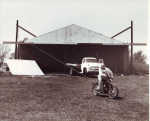Second in a series -- Family spent summers barnstorming

EDITOR'S NOTE -- This is the second in a series of stories about Cedar Bluffs-Oberlin pilot Steve Tuttle, who flew the ground-breaking "Newsboy" airplane for the McCook Daily Gazette in 1929 and 1930. Tuttle couldn't be grounded even after the Newsboy was.
Now ... back to Steve Tuttle, whose love of the sky and flying could not be grounded forever by the unpredictable weather of the Golden Plains or by an enterprising newspaper publisher forced, ultimately, to be practical and business-minded.
Tuttle had taught himself how to fly in 1924, when he was 21 years old -- using a farmer's natural instinct for "trial and error" to get his first plane, a World War I Curtiss JN-4 Jenny, into the air and down again without injury to himself or damage to the Jenny. (Another reference to Steve's first plane indicates that it was a Canuck, a Canadian version of the JN-4 purchased at Blue Rapids, Kan., and flown for him from Blue Rapids to Cedar Bluffs by Harold Metcalf.)

Gazette history illuminates some of Tuttle's early forays into the aviation business, and Tuttle's daughter, Donna, recalls family lore about her father's first attempts at flying.
McCook's early pilots were a tight-knit group, and at some point (after Steve learned to fly, but before 1928), according to Gazette historical records, Tuttle, Forrest Garlick and Ray Search decided to manufacture airplanes. They built their first -- and ultimately their last -- airplane with parts taken from salvageable and discarded planes. When the trio flew the plane to North Platte to license their airplane, license officials said, "No way," because of any number of discrepancies on model/serial numbers on parts.
The three enterprising pilots sold the plane on the spot, and the new owner/pilot crashed it on his way home.
That ended the Tuttle/Garlick/Search airplane manufacturing firm.
One afternoon, early in Tuttle's flying career, he took off from his farm's alfalfa field, landed at his parents' nearby house, took off again and headed for Oberlin. He overshot that landing, however, so, "thinking he was going to show off," Donna said, he decided to fly southeast to Jennings, where the woman who would become his wife, Mable Hansen, was teaching.
"Mother was from Oberlin," Donna said, and had graduated from high school and was teaching eight grades in one-room school houses. "She was really young," Donna said. "Some of her students were about the same age as she was."
Mable was teaching in Jennings when Steve decided to "demonstrate his flying skills" that day he overshot Oberlin. Trouble was, Donna said, the field he chose as a landing strip had been rooted up by hogs and was so rough that, upon landing, the plane bounced, hit the railroad tracks and the telegraph pole and wires, and crashed nose-down in a creek bed. The Jenny's fuselage was bent in half, her pilot pinned in the pilot's seat.
The story goes that Harry Slagle, a salesman from Oberlin, was at a nearby farmhouse and rushed to the crash site, expecting to surely find the pilot crumpled and dead. Donna said her dad is reported to have said to a very surprised Slagle, "If you'd get ahold of the tail and pull it around, I think I can get out of this thing."
Which both men did, Donna said, Slagle in awe and Steve covered in broken glass. It was his heavy leather jacket that saved him, she said. "He was such a dare-devil," Donna said, chuckling about the story of the crash. "... anything he could do that was a challenge ... "
Oh, Steve and Mable were married May 26, 1926.
Steve's next plane was an Eaglerock, which he purchased after he and Mable were married. He painted it red, white and blue, and rebuilt it after it toppled over in a rain storm.
Steve flew to Marian, Ill., to earn a transport license, and, then back in McCook, according to a family history written by Mable Tuttle, Steve then did a lot of barnstorming, carrying passengers and putting on air shows.
One advertisement tempts: "If interested in learning to fly or the purchase of an airplane, write or phone Tuttle Flying Service, Phone 329, at 911 E. Fifth, McCook." The ad indicates that Tuttle was a distributor for Waco Airplanes.
Another ad in the Tuttle family archives is for an "Elks' Benefit Air Circus," with "death-defying rope ladder landing," "racing," "stunting," "balloon busting, parachute jumping, wing walking" and "dead stick loop-the-loop and land," ... "under the direction of Tuttle Flying Service." Tuttle Flying Service was located at the American Legion Airport, McCook.
Donna, Steve and Mable's second daughter, remembers her dad's barnstorming years.
"We spent our summers traveling all over," Donna said. " ... Dad barnstorming, offering rides in a Stinson Tri-Motor."
"Mom and us girls had to go ahead of Dad and the plane to find pastures to land in," Donna said. "No one had seen a plane that big. It really drew crowds -- people would rush to the pastures when Dad landed."
"That's how we spent our summers for years and years," Donna said. "I was just a kid -- I got so sick of it," she continued. "I often thought, 'If we ever get home -- if we ever get a home -- I'll stay there forever.'" She paused, "I'm so happy to be at home ... I'm such a homebody even today."
Even after finding home-based jobs, Steve relied heavily on Mable, Donna said. "Dad depended on her to do so much," Donna said. "Mother was a little bitty thing, but she was really tough."
Donna said, "She sewed like the devil. She sewed windsocks for all the airports, besides what she sewed for us girls."
Next time: Steve Tuttle refuses to be grounded.
